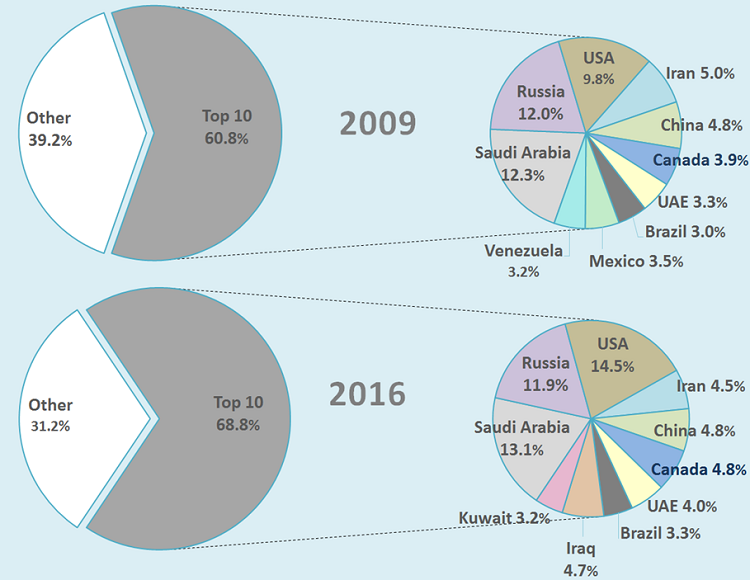Market Snapshot: Top producing countries accounting for higher percentage of world oil output
Release date: 2017-07-26
Global oil production has trended upwards since 2000, increasing from 75.8 million barrels per day (MMb/d) to 94.6 MMb/d in 2016. Between 2000 and 2009, oil production increased by almost 8 MMb/d, but the share produced by the top 10 producing countries remained constant at around 62%. Between 2009 and 2016, output grew by a total of 11 MMb/d, while the share produced by the top 10 increased from 61 to 69%. This increase was driven primarily by production growth concentrated in the United States (U.S.), Canada, Iraq, and Saudi Arabia, and differentiates this second period (2009-2016) from the first (2000-2009), when production increases were spread more widely across a number of countries.
Source and Description
Source: EIA – Crude Oil, NGPL, and Other Liquids
Description: A line graph shows trends in total world oil production and the percentage produced by the top 10 producers, from 2000 to 2016. World production trended upwards between 2002 and 2005, before plateauing at roughly 83 million barrels per day (MMb/d). From 2009, production climbed steadily to 94.6 MMb/d in 2016. From 2000 to 2009, the top 10 oil producing countries produced an average of 62% of world output. After hitting a low point of 61% in 2009, the percentage increased consistently to 69% in 2016.
The most notable production increase was in the U.S. Beginning in late 2008, production of tight oil from previously unproductive rock formations was made possible with technological advances in hydraulic fracturing and horizontal drilling. This caused a boom in American oil production, which increased by 68% (5.6 MMb/d) between 2009 and 2016. This boom also contributed to an increase in the U.S. share of global oil production during this same time period from 9.8% to 14.5%, and accounted for more than half of the increase in “top 10” production concentration.
Source and Description
Source: EIA – Crude Oil, NGPL, and Other Liquids
Description: Two pie-of-pie charts show the percentage of oil produced by the top 10 countries, and the shares of each country in the top 10, for the years 2009 and 2016. In 2009, the top 10 produced 60.8% of global output. The top ten countries, and their respective shares of world production, were: Saudi Arabia (12.3%), Russia (12.0%), USA (9.8%), Iran (5.0%), China (4.8%), Canada (3.9%), UAE (3.3%), Brazil (3.0%), Mexico (3.5%), and Venezuela (3.2%). In 2016, the top 10 produced 68.8% of global output. The top ten countries, and their respective shares of world production, were: Saudi Arabia (13.1%), Russia (11.9%), USA (14.5%), Iran (4.5%), China (4.8%), Canada (4.8%), UAE (4.0%), Brazil (3.3%), Iraq (4.7%), and Kuwait (3.2%).
Over the same seven years, Canadian production increased by over 1.2 MMb/d, and grew from 3.9 to 4.8% of global output. A key factor in this growth was the increasing use of steam-assisted gravity drainage (SAGD) technology, which improved accessibility of oil sands reserves that were too deep for traditional mining. Between 2010 and 2016, SAGD production grew by almost 200% (615 000 b/d), while traditional mining grew by only 34% (295 000 b/d). The production increase was also influenced by the same technological advances that caused the tight oil boom in the U.S., as Canadian tight oil production increased by 280 000 b/d, more than five-fold between 2009 and 2015, before falling slightly in 2016.
Iraq and Saudi Arabia also significantly increased their shares of world production between 2009 and 2016. Both experienced production increases of over 2 MMb/d, which increased Iraq’s share from 2.9% to 4.7% and Saudi Arabia’s share from 12.3% to 13.1%. Notably, Mexico and Venezuela fell from the top ten during this time, while Iraq and Kuwait were added.
- Date modified:

